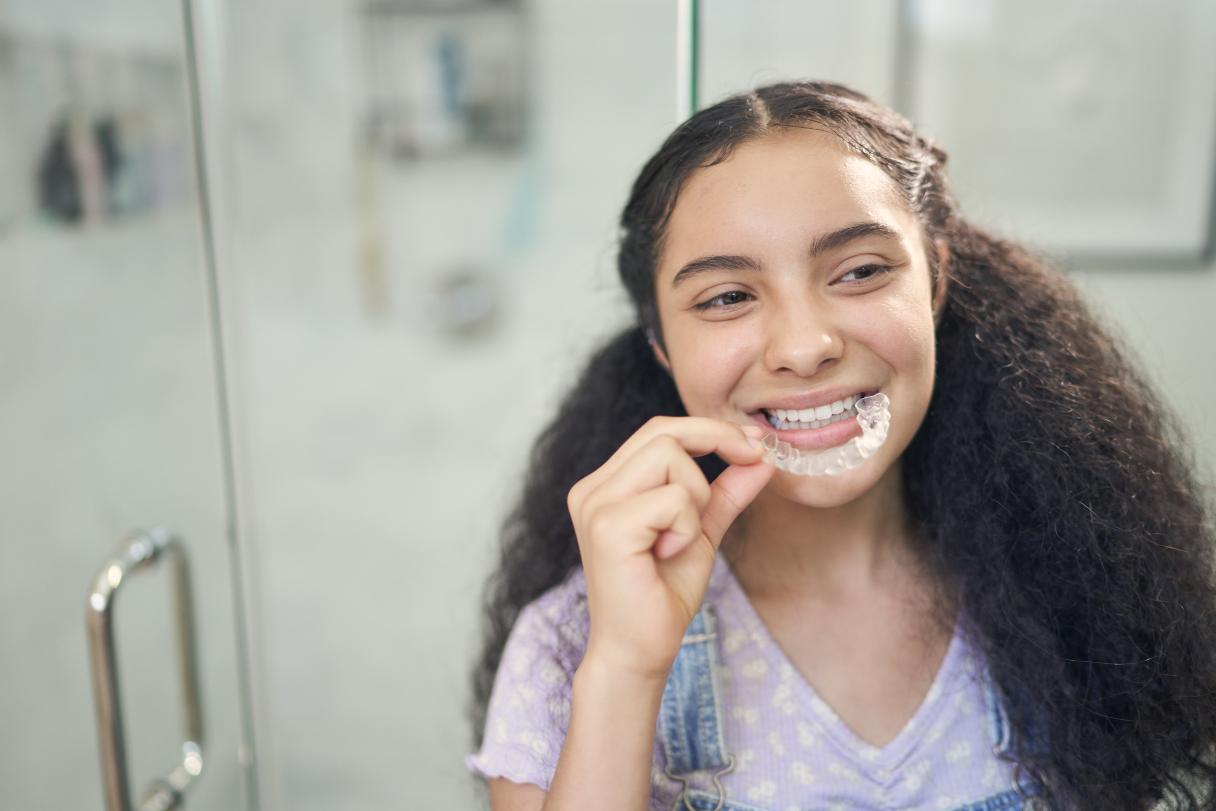Are crooked teeth causing you to hide your smile or even avoid certain social events? Do you think fixing your smile involves years of braces? We have good news: children, teens, and adults have more options than ever for straightening teeth or correcting an uneven bite. Even better news: today's orthodontic treatments include less invasive materials, removable appliances and shorter treatment times.
What Is Teeth Straightening?
Simply put, all teeth straighteners use pressure to move your teeth into the proper position. That includes fixing crooked teeth, crowded teeth and even teeth that are spaced farther apart than you'd like. Teeth straighteners are also used to correct an overbite or underbite.
Common Types of Teeth Misalignment
When your teeth or your bite are misaligned, it's called malocclusion. There are several different types of malocclusions — and it's possible to have more than one at the same time. Here are seven common types of dental misalignment:
- Crossbite: when your upper teeth fit inside your lower teeth. A crossbite can involve the front teeth, back teeth or both.
- Diastema: a space between two teeth. While you may have gaps between several pairs of teeth, the most noticeable diastema is one that appears between the two front teeth.
- Open bite: when your upper and lower front teeth slant outward and don't touch when your mouth is closed. An open bite can develop in the front or back of your mouth.
- Overbite: when your upper front teeth excessively overlap your bottom front teeth when the back teeth are closed. An overbite is also called a "deep bite" or "closed bite."
- Overcrowding: when there's not enough space in the mouth for your teeth to grow in straight, resulting in crooked teeth that overlap each other.
- Overjet: when your upper front teeth protrude. An overjet is sometimes called "buck teeth."
- Underbite: when your lower front teeth or jaw sit ahead of your upper front teeth or jaw.
In addition to these types, there are three levels (or classes) of teeth misalignments:
- Class 1: Minor crowding of the front teeth but molars align; most common
- Class 2: Upper teeth and upper jaw push out over the lower jaw
- Class 3: Lower teeth and lower jaw push out under the upper jaw
Top Teeth Straightening Options
Whatever the dental misalignment, there are options to help you fix it. Take a look at these seven ways to improve your smile:
1. Metal braces
Average cost: $2,500-$10,0001
Traditional metal braces consist of fixed brackets, wires and elastic bands that work together to move teeth into their new position. Brackets are generally made of stainless steel, and wires are made of metal alloys. Today's braces are smaller and lighter than previous versions, and you may even be able to choose the color of your brackets and bands.
2. Ceramic braces
Average cost: $3,000-$10,0002
Traditional ceramic braces work the same way metal braces do, but the brackets are tooth-colored, making them less visible. Brackets are made of ceramic or porcelain materials, and wires are made of metal alloys.
3. Damon braces
Average cost: $2,500-$8,0002
Damon braces include self-ligating brackets — that is, brackets that use a slide mechanism instead of elastic bands to hold the wires in place. While they're less noticeable than traditional brackets, and treatment time may be shorter, Damon braces can also be a slightly more expensive option than traditional braces.
4. Lingual braces
Average cost*: $5,000-$13,0002
Often referred to as invisible braces, lingual braces are placed on the inside of the teeth and hidden from view. They can be an ideal option for those who don't want the appearance of braces. Lingual braces are customized and may be more expensive than traditional braces.
5. Clear teeth aligners
Average cost: $1,800-$8,1001
Clear teeth aligners like Invisalign®, Clear Correct® and Reveal Clear Aligners® include a series of custom-made, removable aligners that you wear like a retainer. The aligners are replaced approximately every two weeks until the teeth shift into their new position. These options are less noticeable than traditional braces and can be easily removed for eating, brushing and flossing.
6. Short-term aligner treatment
Average cost: $3,500-$5,0002
This type of treatment, available through companies like Six Month Smiles®, can be ideal for those who want cosmetic straightening benefits but don't need complex bite corrections. The shorter treatment time and lower cost compared to traditional braces make this an appealing option. The process should be overseen by a professional dentist.
7. Retainers
Average cost: $100-$5003
In most instances, a retainer will be used to hold teeth in their new positions after active orthodontic treatment is completed. These devices may be permanent or removable. However, retainers may sometimes be used as a standalone teeth-straightening option for those who require minimal dental correction.
Depending upon your specific orthodontic needs, dental bonding or veneers may be recommended. These options do not move the teeth into the desired alignment. Instead, they are cosmetic treatments that can give the appearance of a straighter smile.
How Long Does Teeth Straightening Take to Work?
Teeth straightening treatment times vary based on your condition and treatment plan.
Traditional braces are typically worn for 18 to 24 months, while the average length of treatment for Damon braces is 12 to 18 months. Invisalign® treatment time is about 12 to 18 months (based on two-week wear).
Talk with your dentist or orthodontist to determine the right treatment for you.
Benefits of Teeth Straightening
There are many benefits to straightening your teeth, as it can boost your physical, mental and emotional health. Here are seven key benefits:
- Better oral health. Crooked or overcrowded teeth can create hidden pockets that your toothbrush can't reach, leading to plaque buildup and even gum disease. With straightened teeth, it's easier to brush, floss and keep your gums clean and healthy.
- Improved digestion. When your teeth are crooked or your bite is misaligned, chewing can be uncomfortable and inefficient. But with straight teeth and a functional bite, you can fully and properly chew your food, leading to better digestion.
- Decreased head and neck pain. An improper bite can create extra pressure on your teeth, causing excess wear and tear, jaw strain, headaches and neck pain. By straightening your smile, you can balance your bite and alleviate related discomfort.
- Reduced risk of dental injury. If your teeth protrude—particularly your top front teeth—they're more prone to being chipped, cracked or even knocked out. When you get your teeth straightened, they will be shifted back so they're less likely to sustain trauma.
- Clear speech. Your teeth play a key role in the way you speak. If you have a large diastema, excessive overbite, or underbite, you may produce a whistling noise or lisp. Straightening your teeth can eliminate these issues and help you articulate more clearly.
- Improved appearance. Misaligned teeth can keep you from feeling good about the way you look. But when you get your teeth straightened, there's no need to hide your smile. An improved smile can boost your self-confidence and help you make a great impression.
- Better overall health. Poor dental health has been linked to cardiovascular disease, infertility, kidney disease and more. Clearly, oral health affects the whole body. So when you improve your smile, you're taking an important step for your total well-being.
CareCredit Credit Card Financing for Teeth Straightening
Whether you're investing in teeth straightening or you're simply paying for a dental exam, the CareCredit credit card can help you pay for costs not covered by insurance.** Use our Acceptance Locator to find a dentist or orthodontist near you that accepts CareCredit to help get you on track to your perfect smile. Continue your wellness journey by downloading the CareCredit Mobile App to manage your CareCredit account, find a provider on the go and easily access the Well U blog for more great articles, podcasts and videos.
In addition to orthodontics, you can also use your CareCredit credit card for pet care, cosmetic, vision, hearing, health systems, dermatology, pharmacy purchases, spa treatments and so much more within the CareCredit network. How will you invest in your health and wellness next?
Expert Reviewer
Dr. Jorge Oaxaca, D.D.S.
Dr. Jorge Oaxaca is a partner and owner of Oaxaca, Ong & Jensen Seal Beach DDS, located in Seal Beach, California. He has a holistic approach to dentistry and a passion for technology which has led him to practice progressive, cutting-edge computerized dentistry in his office to better serve his patients.
Author Bio
Kristin Driver is a Digital Writer with CareCredit. She specializes in writing about health care, finances and pet care. Her work has been published by Cedars-Sinai, UCLA Health, Stanford Health Care, Risk & Insurance, Modern Health Care, Risk Insider, CIO Review and more.







